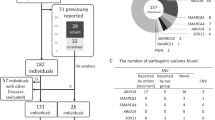Abstract
IT is not widely known, and should be of historical interest, that in 1932 P. J. Waardenburg1 suggested, in a monograph on the human eye, that Down's syndrome resulted from a chromosomal aberration due to non-disjunction. This was 5 yr after the first report of a chromosomal aberration in a mammal2. In 1952, Mittwoch3 reported studying the meiotic chromosomes of a mongoloid patient and judged them to be normal. Waardenburg's suggestion was rarely cited, and the eventual discovery of trisomy–21 in 1959 (ref. 4) was generally received with surprise.
This is a preview of subscription content, access via your institution
Access options
Subscribe to this journal
Receive 51 print issues and online access
$199.00 per year
only $3.90 per issue
Buy this article
- Purchase on Springer Link
- Instant access to full article PDF
Prices may be subject to local taxes which are calculated during checkout
Similar content being viewed by others
References
Waardenburg, P. J., Das Menschliche Auge und seine Erbanlagen (Martinus, Nijhoff, Den Haag, 1932).
Painter, T. S., Genetics, Princeton, 12, 379–392 (1927).
Mittwoch, U., Ann. Eugen., 17, 37 (1952).
Lejeune, J., Gautier, M., and Turpin, R., C. r. hebd. Séanc. Acad. Sci., Paris, 248, 1721–1722 (1959).
Author information
Authors and Affiliations
Rights and permissions
About this article
Cite this article
ALLEN, G. Aetiology of Down's syndrome inferred by Waardenburg in 1932. Nature 250, 436–437 (1974). https://doi.org/10.1038/250436a0
Received:
Issue Date:
DOI: https://doi.org/10.1038/250436a0
This article is cited by
-
De novo mutations in human genetic disease
Nature Reviews Genetics (2012)
Comments
By submitting a comment you agree to abide by our Terms and Community Guidelines. If you find something abusive or that does not comply with our terms or guidelines please flag it as inappropriate.



